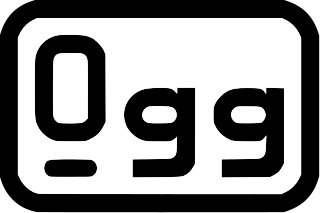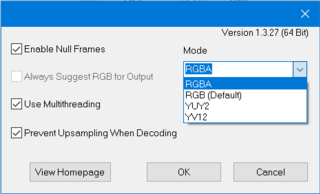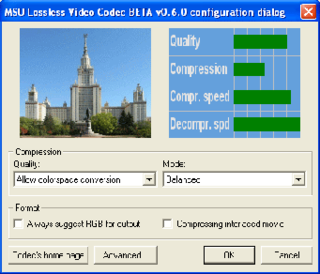Related Research Articles
In information theory, data compression, source coding, or bit-rate reduction is the process of encoding information using fewer bits than the original representation. Any particular compression is either lossy or lossless. Lossless compression reduces bits by identifying and eliminating statistical redundancy. No information is lost in lossless compression. Lossy compression reduces bits by removing unnecessary or less important information. Typically, a device that performs data compression is referred to as an encoder, and one that performs the reversal of the process (decompression) as a decoder.

In information technology, lossy compression or irreversible compression is the class of data compression methods that uses inexact approximations and partial data discarding to represent the content. These techniques are used to reduce data size for storing, handling, and transmitting content. The different versions of the photo of the cat on this page show how higher degrees of approximation create coarser images as more details are removed. This is opposed to lossless data compression which does not degrade the data. The amount of data reduction possible using lossy compression is much higher than using lossless techniques.

Ogg is a free, open container format maintained by the Xiph.Org Foundation. The authors of the Ogg format state that it is unrestricted by software patents and is designed to provide for efficient streaming and manipulation of high-quality digital multimedia. Its name is derived from "ogging", jargon from the computer game Netrek.
Windows Media Audio (WMA) is a series of audio codecs and their corresponding audio coding formats developed by Microsoft. It is a proprietary technology that forms part of the Windows Media framework. WMA consists of four distinct codecs. The original WMA codec, known simply as WMA, was conceived as a competitor to the popular MP3 and RealAudio codecs. WMA Pro, a newer and more advanced codec, supports multichannel and high resolution audio. A lossless codec, WMA Lossless, compresses audio data without loss of audio fidelity. WMA Voice, targeted at voice content, applies compression using a range of low bit rates. Microsoft has also developed a digital container format called Advanced Systems Format to store audio encoded by WMA.
Adaptive Transform Acoustic Coding (ATRAC) is a family of proprietary audio compression algorithms developed by Sony. MiniDisc was the first commercial product to incorporate ATRAC in 1992. ATRAC allowed a relatively small disc like MiniDisc to have the same running time as CD while storing audio information with minimal loss in perceptible quality. Improvements to the codec in the form of ATRAC3, ATRAC3plus, and ATRAC Advanced Lossless followed in 1999, 2002, and 2006 respectively.

FLAC is an audio coding format for lossless compression of digital audio, developed by the Xiph.Org Foundation, and is also the name of the free software project producing the FLAC tools, the reference software package that includes a codec implementation. Digital audio compressed by FLAC's algorithm can typically be reduced to between 50 and 70 percent of its original size and decompresses to an identical copy of the original audio data.
Xiph.Org Foundation is a nonprofit organization that produces free multimedia formats and software tools. It focuses on the Ogg family of formats, the most successful of which has been Vorbis, an open and freely licensed audio format and codec designed to compete with the patented WMA, MP3 and AAC. As of 2013, development work was focused on Daala, an open and patent-free video format and codec designed to compete with VP9 and the patented High Efficiency Video Coding.
The Apple Lossless Audio Codec (ALAC), also known as Apple Lossless, or Apple Lossless Encoder (ALE), is an audio coding format, and its reference audio codec implementation, developed by Apple Inc. for lossless data compression of digital music. After initially keeping it proprietary from its inception in 2004, in late 2011 Apple made the codec available open source and royalty-free. Traditionally, Apple has referred to the codec as Apple Lossless, though more recently it has begun to use the abbreviated term ALAC when referring to the codec.

Huffyuv is a lossless video codec created by Ben Rudiak-Gould which is meant to replace uncompressed YCbCr as a video capture format. The codec can also compress in the RGB color space.
QuickTime Animation format is a video compression format and codec created by Apple Computer to enable playback of RGB video in real time without expensive hardware. It is generally found in the QuickTime container with the FourCC 'rle '. It can perform either lossless or lossy compression and is one of the few video codecs that supports an alpha channel. Supported color depths are 1-bit (monochrome), 15-bit RGB, 24-bit RGB, 32-bit ARGB, as well as palettized RGB. As a result of reverse-engineering of the format, a decoder is implemented in XAnim as well as an encoder and decoder in libavcodec.

Lagarith is an open source lossless video codec written by Ben Greenwood. It is a fork of the code of HuffYUV and offers better compression at the cost of greatly reduced speed on uniprocessor systems. Lagarith was designed and written with a few aims in mind:
The following tables compare general and technical information for a variety of audio coding formats.
MPEG-4 Audio Lossless Coding, also known as MPEG-4 ALS, is an extension to the MPEG-4 Part 3 audio standard to allow lossless audio compression. The extension was finalized in December 2005 and published as ISO/IEC 14496-3:2005/Amd 2:2006 in 2006. The latest description of MPEG-4 ALS was published as subpart 11 of the MPEG-4 Audio standard in December 2019.

MPEG-4 Part 14 or MP4 is a digital multimedia container format most commonly used to store video and audio, but it can also be used to store other data such as subtitles and still images. Like most modern container formats, it allows streaming over the Internet. The only filename extension for MPEG-4 Part 14 files as defined by the specification is .mp4. MPEG-4 Part 14 is a standard specified as a part of MPEG-4.
FFV1 is a lossless intra-frame video coding format. It can use either variable-length coding or arithmetic coding for entropy coding. The encoder and decoder are part of the free, open-source library libavcodec in the project FFmpeg since June 2003. FFV1 is also included in ffdshow and LAV Filters, which makes the video codec available to Microsoft Windows applications that support system-wide codecs over Video for Windows (VfW) or DirectShow. FFV1 is particularly popular for its performance regarding speed and size, compared to other lossless preservation codecs, such as M-JPEG2000. The European Broadcasting Union (EBU) lists FFV1 under the codec-family index "31" in their combined list of video codec references.

The MSU Lossless Video Codec is a video codec developed by the Graphics & Media Lab Video Group of Moscow State University. It was designed to provide space-effective lossless video compression. As of 2007 MSU had the second-best compression ratio when compared to many other lossless video codecs, with the better result shown by YULS codec.

aptX is a family of open audio codec compression algorithms, with a heavy emphasis on wireless audio applications.

An audio coding format is a content representation format for storage or transmission of digital audio. Examples of audio coding formats include MP3, AAC, Vorbis, FLAC, and Opus. A specific software or hardware implementation capable of audio compression and decompression to/from a specific audio coding format is called an audio codec; an example of an audio codec is LAME, which is one of several different codecs which implements encoding and decoding audio in the MP3 audio coding format in software.
References
- ↑ Seleznev, Iwan & Smirnov, Maxim (March 2007), Vatolin, Dmitriy (ed.), "Lossless Video Codecs Comparison '2007" (PDF), Video Group, MSU Graphics & Media Lab, retrieved 2011-11-27
- ↑ "YUVsoft's Lossless Video Codec Change Log" (txt), YUVSoft, retrieved 2011-11-27